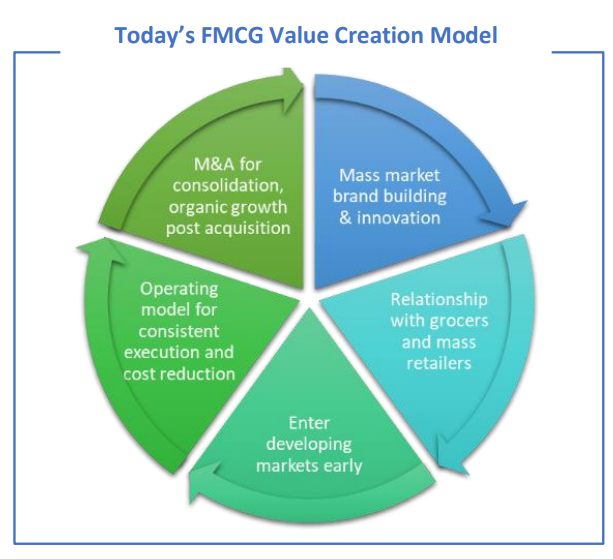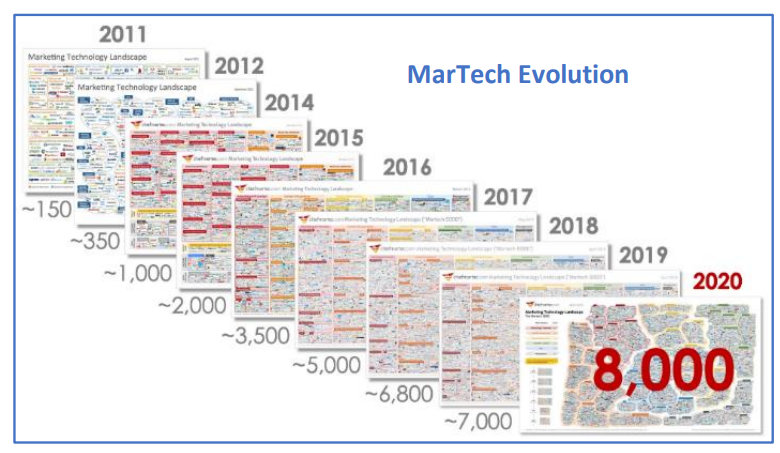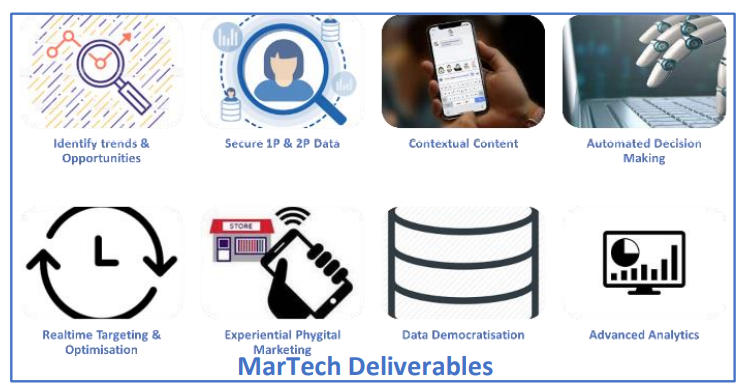July 6, 2021
Submitted by Zaved Akhtar, CEO and MD, Unilever Bangladesh
1.0 The FMCG Value Creation Model

One of the most well-oiled machines is the FMCG value creation model, where one designs products for the lowest cost, delivers through the most efficient go to market channels, while ensures operations are run in the most cost-effective fashion that enables businesses to generate sufficient cash for entering attractive markets or make acquisitions that can complement their organic growth. This simplistic articulation was well captured by McKinsey & Company in the 2018 article, The new model for consumer good . A good read to build one’s appreciation.
2.0 Implication for the Model: a David vs Goliath Story
This value creation model is however getting outdated and challenged as increasingly large FMCG companies across multiple geographies are losing in many of its subsegments and unable to garner organic growth. Newer, smaller companies have been nimbler to work on the ‘niche’ opportunities and nibble into the pie, leaving the FMCG behemoths struggling for growth. Such dramatic shift has been driven by some discernible changes in competitive model where each of Porter’s 5 forces has been challenged as consumer journey’s evolved, i.e., consumers becoming independent information gatherer and forming their own opinion about the brands, brands are not seen as trustworthy allies in disseminating fair and transparent information, consumers are well trained to see through advertising and advocacy; customer and supply chain barriers for entry are also going down as ecosystem collaborates and supports each other; all of these culminating to the famous Byron Sharp theorem that loyalty is overrated and reiterating the importance of constant customer acquisition, i.e., building brand penetration.
3.0 Need for Recrafting the New marketing Model
This conundrum now brings into perspective an important fundamental challenge in marketing approach where we need to shift our traditional marketing model to a trinity ecosystem where experience is at the heart of product, brand, and consumers as we leverage technology.
• Product Experience: Tangible, functional delivery of the brand’s promise through discernible and visible product benefit
• Brand Experience: Totality of all sensations, emotions, feelings, thoughts, and actions that a customer experiences when evoked by a brand
• Consumer Experience: Customer’s perceptions and related feelings caused by the one-off and cumulative effect of interactions with a supplier’s employees, systems, channels, or products
4.0 Need for an Exponential Model for New Age Marketing
The current FMCG marketing model is still very linear while the new age marketing model is a wicked problem (a social or cultural problem that is difficult or impossible to solve—normally because of its complex and interconnected nature) that requires integration of Systems Thinking (a way of viewing systems from a broad perspective that includes seeing overall structures, patterns, and cycles in systems, rather than seeing only specific events in the system). Such an amorphous concept necessitates the need to be broken down, and to be looked from the perspective of the shift needed in skillsets as well as looking into the enablers for exponential convergence.
Critical Marketing Skillset Shifts:
• Design Thinking over Mix Validation: The typical FMCG consumer research and insight generation model entails a rewind of the historical data, look at the knowledge gaps to drive divergent thinking and then look for evidence for convergence. This needs to shift now and needs to be anchored in understanding customer's needs, rapid prototyping, and generating creative ideas— that will transform the way we develop products, services, processes, and organizations. While business thinking is a critical prerequisite, one needs to empathise, define the problem, ideate, prototype, and test to remain nimble yet steadfast in the new world.
• Growth Hacking over Growth Scouting: Move from finding segmental opportunities and plugging portfolio gaps to rapidly test ideas that can improve the customer journey, replicate and scale the ideas that work, and finally modify or abandon the ones that don't before investing a lot of resources to scale fast.
• Hyper personalisation over Mass standardisation: Henry Ford once said, “You can have any colour you want as long as it’s black”; we have come a long way from there and now ~81% of the colours are white, black, silver and gray, there are multiple hues that fill up the tail . While one can debate whether it would be segment of one or n+1 or n+2 so and so forth, the point is that we need to make sure that the product or service is designed to the point that balances consumer’s personalisation needs vs the right value creation model for the business and the brand.
• Customer Experience over Customer Service: While designing our brands we must keep customer experience at the centre where we need to ensure that every interaction of the customer, from navigating the website to talking to receiving the product/service they bought from us, is seamless and frictionless. In fact, we need ensure that we eliminate the need for customer service as that tends to address problems or concerns which would be a deterrent to the holistic perception of building experience of our business or brand.
• Behavioural Science over Purchase Behaviour Norms: Typical FMCG relies significantly on the historical purchase behaviour and leverages those data to predict future behaviour. This assumes a very linear approach but, the human cognitive process is much more dynamic and are impacted by many other external stimuli. The marketer of the future needs to marry internal and external data to have strong understanding of the behavioural interactions and business impact on the brands.
Mission Critical Enablers: • Sustainability at the Centre: Societal challenges have raised expectations about marketers as people look for brands to deliver on functionality while also better future and drive societalchallenges, address climate crisis and be more socially inclusive. As we build new skillsets, we need to make sure that every action has sustainability at its core.
• The Artist vs the Operator: Typical mass marketing runs on the theme of ‘efficiency-based effectiveness’ and hence classically shrewd operators excel. But the future will tilt in favour of the artist that can paint the big picture and is ambidextrous with all the consumer facing levers to ensure brilliant execution.
• Data, Tech and Analytics: While being an artist, marketers need the ability to work comfortably with data and leverage tech to get the best analytics out. This would mean balance understanding of small and big data to ensure that every decision is data led and machine augmented.
5.0 Role of the New Age CMO
This is an often-debated topic within the marketing fraternity whether the role of CMO is dated and whether there is relevance or need for such a role anymore. Multiple theorems exists and while the jury is still out, my personal diatribe on this issue is that instead of trying to take the role and dissect it, the organisation is better poised if it can articulate what it needs to solve for. From my vantage point, I believe that the role has morphed beyond the obvious one around marketing to a much more complex web of challenges, i.e., driving sustainability agenda, delivering sustainable growth, devising highly personalized customer experiences, instigating advanced marketing innovation, new business model and driving behavioural shift and change management within the organisation.
• Digital Evangelist: The organisation needs the CMO to crystal ball gaze to show what lies ahead and how we can leverage technology to build a competitive advantage for the business.
• Growth Promoter: Growth needs to be at the centre of the CMO’s agenda with each action impacts the P&L, whether top line or bottom line. This ensures that the central marketing organisation is rooted in the business.
• Innovation Regent: Whether new business model, product innovation process to the disruption in ecosystem, CMO needs to be at the centre set of driving this transformation.
• Capability Leader: Given the speed how external environment is changing there will be a constant need to up skill people and infuse external ideas and thoughts within the business. The scope of the role will also need to frame the capability schema for the organisation for today and for tomorrow.
• Change Catalyst: An often-overlooked role is being the lead in driving and embedding change within the business. This requires quite a lot of manoeuvring through the rungs of the organisation to embed and drive the change. This is not an easy job, and it does take a lot of mental bandwidth and patience to change the organsiation, typically one person at a time.
• Culture Warrior: Much famed quote from Peter Drucker on “Culture Eats Strategy for Breakfast” could not be even more relevant in today’s time. As CMO, one needs to create the environment for iterative, rapid experimentation, fast failure, and mesh tech and business together for optimal outcome. An organisation is bound to go through a Culture Shock and the CMO needs to be the mariner that navigates the individual out of it.
Given the width of the scope, CMO title is a misnomer, and the apt role is more of a ‘Chief Enterprise Transformation & Growth Officer’ with the T shaped skill set, where the individual has deep expertise in marketing while wide appreciation of the end-to-end business. The role will also require a lot of heuristic learning over the typical handed down knowledge, largely given that the space one would be operating will be largely uncharted.
6.0 MarTech Tools: What, Why and How of it
While the marketing is going through such a dramatic shift, one of the pivotal shifts is also in flight where we are moving away from the marketing skillset of spray and pray of trying to hit billions of unnamed people to a more deterministic set of directly attributable individuals. This will mean we need to have a holistic understanding of the consumer and create opportunities for engagement throughout the consumer journey and lifecycle. The reality of the future is also to win beyond direct competitors to a much broader pool of experiential competitors & perceptual influencers. This will mean that from the typical AIDA (awareness-interestdesire-action) model we need to a more iterative solution where we do have a clear value exchange program for the consumer which gets delivered seamlessly as we build strong and constant engagement and interactions to build long imbibing relationship by reaching to consumers in newer, more effective, personalized ways and generating deeper impact and generating much higher ROI. This is where MarTech can be a critical differentiator.

• India vs Global MarTech Digital spending is changing for India and there is an increasing need for solutions fit for India. India MarTech Survey 2020 states that 80% of marketeers will spend more behind tools and technologies given the increased business need for ROI on digital investments. People will dabble more and more into the space as we see acceleration of spends but despite the increasing ubiquity of the technology an era of experimentation is upon us as most marketers lack the skills cross-organisation. MarTech technology stacks which were a mere 150 tools at the start of the decade now has grown to a whopping around 8000 suites, a growth of more than 5000%. This makes the decision on MarTech a bit more complicated. However, while globally there are a lot of tools available, there may be a need to create bespoke tools that caters to diversity of India as well addresses the role voice and vernacular will play in future. There will also be need to de-average data for multiple Indias across geographies, consumer classes and channels etc to ensure effective data management for purpose.

• MarTech tools and Building an Effective Stack The challenge of building the most effective marketing technology stack is that not one size fits all solutions and the recommendation vary based on evolution of digital marketing and the business appetite. The most effective solution one looks for is how the MarTech stack can leverage the data master to marketing analytics to actionable insights leading to business impact. But not all the elements need to grow at the same pace and nor do we need to create a full end to end solution at one go. This will mean Ideally, we need to step back and look at what are our end-to-end data driven planning, execution, and optimisation and based on that assessment we could curate the essential elements for constructing the ideal stack.

The challenge for any CMO is the temptation of designing for the full solution or deliver for part of it. It is a difficult choice as a full best in class solution that addresses the spectrum of the need may just be too expensive and the organisation may not be ready to fully leverage the capabilities. The best way to approach is to investigate the most important business need and look at which ones need to be solved first and build collaborative modular suites that interacts with each other well. I would recommend the following 5 steps for building the ideal tech stack:
Step 1 - Audit Current Challenge: It is always prudent to look back and understand what is holding back and what are the gaps for brilliant consumer or customer engagements. This will ensure that you have clearly defined if the challenges are in lead generation or understanding data or content management. Whichever it may be one can acquire the right platform for the right cause.
• Step 2 - Set your Priorities and Goal: Once the gap has been identified, clearly articulate the priorities and the marketing suites can connect well and addresses the specific needs and what it will achieve.
• Step 3 - Build Foundation: Even the best of the marketing suites does not need the full end to end solution. Rather the focus should be to build the critical ones as a modular solution and then add as and when needed. The critical ones ideally one needs to acquire is Automation, Customer Relations Management (CRM), Content Management System (CMS), Customer Data Platform (CDM) and a decent Analytics Platform. Once we have leveraged these capabilities well, we can then explore newer and advanced modules.
• Step 4 - Benchmark against the market: It is always important that you benchmark the capability on what is available in the market and used by the peers and competitors. Typically, this will give a good perspective of what level of investment needs to be made.
• Step 5: Modular Roll out: Highlighted earlier, instead of going fully head on, the best course of action is to design a destination architecture and then build this as a modular capability; add once you have saturated the capability in full.
7.0 Conclusion:
Marketing has Changed but Data has Made it more Relevant Marketing will never be the same but will be even more relevant during this time. Henry Ford once famously said, “Stopping advertising to save money is like stopping watch to save time.” The future will be of a more anticipated, relevant, and personal communication over unsolicited, impersonal propaganda. We are at a time of history where we need to build more personal emphatic messages for people and build a lasting bond by being a better storyteller than ever. We need to be cognizant about the new skillsets and capabilities to build a frictionless consumer and customer experience. At the heart of this will be the barrage of data that will flood us and our ability to distil and connect it well to ensure that we are able to read, anticipate leveraging the right technology and acting on to build brilliant consumer and customer experience.
References:
https://www.mckinsey.com/industries/consumer-packaged-goods/our-insights...
Porter's Five Forces: Stay Ahead of the Competition
How Brands Grow: What Marketers Don't Know by Byron Sharp
https://www.axalta.com/content/dam/New%20Axalta%20Corporate%20Website/Do...automotive-color-popularity-report.pdf
https://landbot.io/blog/martech-stack/

